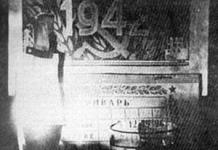It is generally believed that graffiti stencils can significantly simplify the process of creating it. This is not entirely true. The simplest is wild style graffiti, which most often corresponds to bombing. In this case, it is better to call artists artists, but you can also call them graffiti bombers, and their main task is to make recognizable inscriptions or graphic symbols, do them quickly and do them in the most unexpected but crowded places. In some cases, the scandal surrounding the artist’s name is created precisely by the fact that he operates where he is not supposed to.
Sequence of work on the stencil
In any case, if an artist has a creative idea, it first appears on paper. The answer to the question of how to make a stencil for graffiti is quite simple - draw and cut. But only with experience comes the ability to combine a plan with the technique of its practical implementation.
1. First a sketch is created
This is a drawing that initially implies that those parts of it that will be completely painted over with some color are intended for cutting out. One of the main tasks that a sketch solves is to find a balance between expressiveness and simplicity. Beginning artists are recommended to work with one, or maximum two, colors. Therefore, when developing a sketch, you need to look for a simple form that will express complex emotions.
2. The sketch is transferred to paper, film or cardboard
Everyone can find some better way. You can use carbon paper, first transfer the image onto film or transparent paper. When choosing cardboard, you should look for thin and dense options that can withstand any moisture and paint well. Thick and dense coated paper, as well as thick film, may be suitable.




When transferring, only thin lines of the main contour should be formed. Then the process of refining the image and creating bridges begins. These are the areas that will connect the space to be cut out with everything else. For example, without bridges it is impossible to make a stencil of the letter o. The result will be an oval, not a letter. If you cut out the space of the letter's outline, but leave the bridge, then the middle part will have something to hold on to.
3. Cutting
The larger the area from the outermost detail of the design to the edge of the sheet, the easier it will be to work with the stencil. Cutting is best done using a wood cutter, extremely sharp and sharpened at an angle.




4. Transferring the stencil to the wall




Multicolor image
When creating images in several colors with your own hands, you will have to make a color layout similar to that used in printing. You should get a stencil for each color. In this case, two options are possible.
Each color is cut out separately strictly along the contour as it is in the overall picture. So, to depict a tree with green foliage against the sky, you need to make two stencils - one for the leaves and one for the trunk with branches, since they have different colors. However, the cut out areas may be adjacent to each other, or may cover areas of other colors. For example, first everything is painted blue, a background is given, then a green stencil is used. After completing work with it, the entire crown of the tree will already be in the picture, and then an image of the branches that fall on the green area is applied and superimposed on top of it.
The specific method depends on the artist’s intention, the characteristics of the composition and his experience. To begin with, you can use a ready-made template, but only in order to master the technique itself. A true master creates himself, or he is not an artist. The same can be said about the use of graphics processors. With their help, you can do creative work in the same way or find an easier way to turn a photo into an image. There is no need to try to automate the process of creating your works without special reasons. If this happens, automation will become part of the creative process. But this is only possible if it suits the individual style of the street artist.
Tutorial on creating a stencil sketch in Adobe Photoshop:
Causes of stencil graffiti
They began to use a stencil for graffiti because there was a great desire to depict something meaningful, beautiful, and original on the wall of a house or on a fence, but the conditions themselves did not allow this to be done. Anyone can conduct such an experiment. Draw a silhouette of a person or some fairy-tale character on a piece of paper. And then try to draw the same one on the wall. You can choose some abandoned house where no one will see you and drive you away, and subsequently they will not punish you. But the experiment will make it clear that the wall creates completely different conditions. Its distinctive feature is unpredictability.
The fact is that this is not a flat wall, which is evenly plastered or painted, but an area that can be discovered during active research of the urban environment. Of course, street art can be different, some are created slowly and under completely legitimate conditions, but we are talking about how this happens most often. Usually it is necessary not only to quickly create at least the basis of a future work, but also to do it despite what the material is, without paying attention to unevenness, cracks and its very nature - whether it is a brick wall or a metal sheet. Therefore, graffiti artists strive to master methods that will allow them to transfer not even a drawing, but the creative concept itself, onto the wall. For her sake, you can go to any tricks...
Painted walls are becoming increasingly popular. But sometimes you want to break up their monotony with something. The easiest, fastest, cheapest and most effective way is to use stencils for walls to be painted. The drawing is graphic, clear and bright. Such objects can fit into any environment. But the best part is that the work takes from a few minutes to several hours.
What are they made of?
Stencils for decorating walls for painting are divided into reusable and disposable. Depending on the purpose, different materials are used. Disposable ones are mostly paper. Made from thick white or colored paper. Reusable stencils for walls for painting are:
A few words about vinyl stencils for painting walls. They can be in the form of sheets or in rolls. If you are going to cover a large wall surface with one pattern, it is advisable to take several identical templates. They can be fastened to each other. This way the work moves faster - a larger area is processed at one time.
Types of stencils
Stencils for walls for painting vary not only in the material from which they are made. They also differ in the type of pattern:
- Simple or single. The entire drawing is painted with one color. If desired, you can make a gradient - from a darker shade to a lighter one. But that's all. Parts of other colors are not available.

- Combined or multi-colored. This is a whole series of templates, each of which is painted with a different color of paint. To ensure that the details of the drawing match, marks are applied to them. When placing the stencil on the wall, these marks are aligned.

For this painting, two stencils were needed - one for black and one for red.
- Reverse or anti-stencil. This template is cut out according to the reverse principle, that is, what is cut out in ordinary templates remains in this one, and it is these parts that are mounted on the wall. Then paint is applied, but it paints the areas not covered by the stencil. It turns out that there is a halo around it from a different paint, but the drawing itself remains the base color.

- For three-dimensional drawings. Decorative plasters and putties are now on sale. They can also be used to apply designs to walls. Stencils for them are made specially - thick, made of polyvinyl up to 4 mm thick. When applying the pattern, the slots are filled with putty and left until dry. The result is a three-dimensional drawing.

It's easiest to work with simple templates. For starters, you can try this type of pattern. If you are confident in your abilities, you can work with more complex combined ones. When working with them, remember that you can remove the film only after the paint has dried.
Where to get templates
There are ready-made templates for wall decoration on sale. They are all made from vinyl film as it is flexible, durable and lightweight. If you don't like ready-made templates, you have two options:
- Order production from a company engaged in outdoor advertising or printing booklets (often this is the same company). They have special equipment - plotters, which cut out the necessary outlines on vinyl. Moreover, some of them can develop a stencil for you based on a photograph.
 Beautiful birds and animals are another win-win option
Beautiful birds and animals are another win-win option  Stencil of dancing cranes - according to popular belief, good luck
Stencil of dancing cranes - according to popular belief, good luck - Do it yourself. If you have artistic abilities, it is likely that you will be able to draw the pattern yourself. If not, download the version you like, enlarge it to the required size and print it. Take thick (not packaging) cardboard, put a carbon copy, and a drawing on top. Everything needs to be firmly secured so that it does not move. While tracing the drawing, transfer its contours to the cardboard. Then cut it out with a sharp knife. To make cutting easier, place something soft (a piece of felt, for example) under the cardboard. This will make the edges smoother. In general, when making it yourself, you need to be careful - every burr or unevenness spoils the overall impression.
 Stencils for walls for painting: cats are a win-win option. These are more difficult to make - more fine details
Stencils for walls for painting: cats are a win-win option. These are more difficult to make - more fine details
Making stencils yourself is a painstaking task. If this doesn't scare you, go for it. You can try working with film. It requires a very thin and sharp, but rigid blade. If there are even small defects - a burr, uneven edges - everything must be corrected. In general, good luck to you.
How to work with stencils
You can apply the design not only to painted walls, but also to wallpaper, plastic, glass, etc. That is, stencils for walls for painting can be used not only to decorate walls, but also to decorate furniture facades, for example. Only highly textured surfaces are not suitable. You cannot apply paint to them properly. All others are suitable. Moreover, acrylic paint is compatible with almost all. They can be in a jar or aerosol. The advantages of acrylic are known to everyone: the paint adheres well to both smooth and porous surfaces, dries quickly, does not fade for a long time, and has almost no odor. That is why stencils for painting walls are usually painted with acrylic paints.

What to work with
If an anti-stencil is used, then paint is applied only from a can. You cannot achieve this effect with other tools (except perhaps a spray gun). When spraying paint, the can is located 25-35 cm from the surface to be painted. It is better to select the distance by doing a “pen test” on a piece of old wallpaper. This way you can accurately select the duration of paint dispensing, movement, and distance. And one more thing: when working with a spray can, it is necessary to additionally protect the areas adjacent to the stencil so that careless movement does not end up painting an unnecessary part of the wall.

You need to work with paint in spray cans carefully - its quantity is difficult to control
When working with all other templates, you can use:

In any case, we take paint in limited quantities. If there is a lot of it, it will flow under the stencil and ruin the whole job. Therefore, after dipping the brush/foam rubber/roller into the paint, we squeeze it out well. The amount of paint can be checked by running it over an unnecessary sheet of paper/piece of wallpaper several times.
What and how to fix it
To prevent stencils for painting walls from moving, they must be fixed to the wall. There is a special glue for this. It is applied in a thin layer to the back of the stencil, after which it is attached to the wall. After completing the work, removing it is not a problem. Moreover, it does not damage the surface.
Another option is double-sided masking tape. Note! Masking tape is a must. Unusual. If you use a regular one, it will damage the wall - most likely, a piece of paint will remain on the tape. Or vice versa, part of the sticky composition will end up on the wall. Which is no better. But masking tape acts approximately like the glue described above: it holds well and does not leave marks after peeling off.

Scotch tape is easier to buy and cheaper, so most people use it. We cut it into small pieces, remove the protective film on one side and glue it to the stencil. You need pieces in the corners - that's for sure, but they may also be needed in the middle of the long side of the sheet or somewhere else. It is important that the stencil holds well and there is no possibility of moving it.
The procedure for transferring a picture to the wall
You need to work with a stencil for painting walls like this:

Then, if necessary, we repeat the procedure. Next time you need to check whether the paint left over from the previous time has dried. Can only be used after complete drying. Dried several times, the paint forms a thick crust. This may cause it to flow between the stencil and the wall, or the shape of the design will change. Therefore, after several uses, remove the paint.
Features of working with a volumetric stencil
To create a three-dimensional image, you can use textured paint, putty, decorative plaster, liquid wallpaper and other similar compositions. You can find special formulations in stores, but they are very expensive. In this part, the choice is yours; all the compositions listed above are suitable.
All of the materials listed above have a paste-like consistency. There is no point in applying them with a brush or roller. You need a small spatula, preferably a flexible plastic one. If you don't have it, you can use a piece of any plastic. Even an old plastic card will do.

We take a certain amount of the composition on a spatula, fill the cavities with it, immediately removing the excess with the same card. At this stage, you need to make sure that there are no air cavities left and that the surface filled with plaster/putty is smooth. If you've ever worked with plaster, you won't have any problems. Everything is exactly the same.
After the composition has set, but before it dries completely, remove the stencil. In this case, the edges of the picture turn out torn and uneven. Don't be upset, this is normal. Don't do anything, just wait for it to dry completely. Now we take sandpaper with medium or fine grain (depending on the composition that was used) and sand all the nerves. In general, that's all. Then, if you want, you can color the resulting ornament, but that’s another story.
Choosing a location for the stencil
The drawing looks best on an empty or almost empty wall. Here the choice is unlimited. You can choose a stencil that will attract attention. This wall becomes an accent wall.
If the wall is not too busy - there is a piece of furniture next to it, but most of its surface is free, choose a stencil that will make the furniture “play.” There are drawings that play off a sofa or a mirror, turning everything into a single composition.

Tall and narrow stencils near doors and windows fit well. Usually these are floral ornaments. When choosing them, be guided by the design style of the room. If the decor is colored, choose the colors that are found in the interior.

The best way to hide is to pay attention
Small drawings that play off sockets and switches look very good. This is one of the decorating techniques - if something cannot be hidden, let’s shift attention to it. In this case it works great.
Type of stencil for different premises
Stencils for walls for painting are selected depending on the type of room. There are universal designs: geometric, floral patterns, landscapes. They are suitable for any room, hallway, kitchen, etc. You can find a lot of them, in different versions. And under strict minimalism, and under chic classics or romantic Provence. Moreover, it is often not only a matter of the drawing itself, but also the selection of paint. The same pattern will look different in black and pink. And this is worth remembering.

There are stencils for walls for painting with thematic designs that are appropriate only in certain rooms. For example, in the kitchen they usually use thematic pictures with food and products. In nurseries they often draw cartoon characters for smaller children, and for teenagers - game or anime characters.
For bedrooms they are trying to find calmer designs. Even if it's a man's bedroom. Here you need to relax and the atmosphere should be appropriate.

In other rooms - corridors, living rooms, dining rooms - neutral images are selected that will appeal to people of different ages. These are all the same plant motifs or landscapes.
Stencils for walls for painting: photo
The number of possible drawings is impossible to count. Different styles, elements, sizes. Graphic, fantasy, from cartoons, based on paintings, photos, schematic and realistic images of flowers, insects, animals, trees... In general, there is everything. You just need to find it. Some interesting options have been collected in this section. Perhaps you will like something.


Stylized animals and cartoon characters - stencils for walls for painting in children's rooms

Floral patterns - unobtrusive and calm


Even one sheet is a work of art


Linear or border stencils, elongated upward compositions - all based on plant motifs

Stencils with dragonflies... and if you choose fluorescent paint, the effect will be unexpected

Flowering trees are a symbol of spring and eternity
- an eternal theme... they are also on the stencils

Bamboo, spikelets - different styles, but how beautiful...

Flowers are another win-win theme for interior decoration

Simple and promising...
Graffiti has quite a long history, and during its existence it not only developed and improved, but grew like a tree in height and breadth (and continues successfully today). Rating, bombing, tagging all this brings together the art you love. Now we will focus on stencil art or stencils. Don’t rush to look for where to download graffiti stencils. You can make them yourself.
Many representatives of the new school of movement do not agree that stencils flowed from graffiti, but their relationship is simply undeniable. Steinsyls carry the same background as the drawings: rebellion, appeal, protest; conveniently placed on the same walls, often in addition to graffiti; The same cylinders are used for application (often remnants from bombs and pieces). Does anyone here still doubt it? No? Then let's move on. How to make graffiti stencils?
First of all, I would advise beginners to decide on the style of their future staincils. As a rule, it is accepted that stencils carry a certain meaning, a social orientation, something like the inscription “Find the time to smell the flowers!” under a drawing of a little girl smelling a flower. But in any modern youth subculture, frames are not welcome, so your stencils can be simply cool, and bring a smile, or even be an abstraction that no one understands.
Almost always, a stencil is a small one-color stylistic drawing and an accompanying, most often explanatory, inscription. There are also multi-colored complex stains that can hardly be distinguished from graffiti, but it’s too early for you to climb Everest. So, the style has been chosen, the head is full of ideas that just can’t wait to jump out with paint on the wall for everyone to see, all that’s left is to make a graffiti stencil.

Since the stencil can and should be used more than once, your city is large, and each quarter needs to express itself, then first of all we are interested in durability and strength. A standard sheet of A4 paper is enough for 1-2 times, so we choose cardboard, ordinary thick cardboard like shoe boxes, without cavities inside (like refrigerators). Next, you should draw the design directly on the cardboard (personally, I draw in Photoshop, print it on a printer, glue it to the cardboard and cut it out), if you don’t have a printer, it doesn’t matter, a black gel pen will perfectly outline the contours.
Then we cut it out, for this it is best to use stationery knives; in extreme cases, a father’s blade will do. After repeated use of such a stencil, it is covered with numerous layers of paint, and becomes hard like plastic, and at the same time, such a stencil is easy to break in half; you need to carry it in some kind of folder or put it inside a newspaper. Linoleum can solve this problem; cutting on it is somewhat more difficult, but you can fold it into a tube and carry this compact package in your backpack. By the way, everything needs to be cut out extremely carefully, without leaving any burrs. It didn’t work out the first time - it’s worth redoing it rather than leaving daubs on the walls of the city.

Be sure to wear gloves when you draw stencils, preferably disposable, cellophane ones; you can buy them in hardware stores or steal them from women who sell candies and cookies at the market.
And the last thing: it is better to choose sharply contrasting colors for applying stainsil - I advise you to choose black, white or yellow paint, and apply it to surfaces of uniform color, otherwise the visibility of your creation will be close to zero. I hope I clearly explained how to make a graffiti stencil. If anything, ask questions in the comments and I will definitely answer them.
You can buy cool paintings as a gift or for interior decoration here oil paintings for sale. Making your life more beautiful is very simple. Paintings are what give us joy and lift our spirits. Just order a painting online and enjoy.
Stencils make graffiti easy and quick to apply and are ideal for beginners. Unlike drawing by hand, stenciling provides crisp, precise lines and helps achieve a high level of detail. The stencil is created in advance, before applying graffiti, so the drawing process is significantly accelerated: just attach the stencil to the wall or canvas and spray paint on it, and then remove the stencil. Keep in mind that painting on the walls of public buildings is against the law - instead, try using your new stencil on the walls of graffiti parks, within your garden, or on large canvases to decorate the walls of your home!
Steps
How to create your own stencil
- If you're just getting started with graffiti, you'll probably find it easier to use a ready-made image for your stencil rather than trying to create your own design.
-
Shade in your sketch the areas you are going to cut out. Use a pencil to lightly shade the areas that you will then cut out and fill with paint. If you are going to make a color drawing, fill in the sketch with different colored markers according to your design.
- As a result, you will get a sketch of the future stencil with shaded or painted areas, which you will cut out and fill with paint. Other places will cover the surface from paint, leaving the background color (wall or canvas) in them.
-
If necessary, provide bridges in your sketch. When creating a sketch of the future stencil, you need to remember several important things, one of which is the so-called bridges. They hold the islands that would otherwise fall out of the stencil after you cut it out.
- The easiest way to understand what bridges are is to imagine the letter O. If you are creating a stencil with the letter O, you should cut out a circle in the shape of this letter in the paper.
- However, if you cut a full circle into the paper, the middle part of the O will simply fall out, leaving you with a large black circle instead of a letter.
- To prevent the central part of the letter O from falling out, it is necessary to use bridges in the form of vertical stripes that will connect the circumference of the letter O with its central part. In this case, the shaded part of the letter will resemble parentheses rather than a solid circle.
- Look at the resulting sketch with a critical eye. If you notice that additional bridges are needed somewhere, erase the shading in these places.
-
Simplify parts of the sketch that are too complex. Without proper experience, it is difficult to say whether the stencil will be successful. Often simple and stylized areas will print and look better than complex areas with a lot of small details.
- For example, if you are sketching a face, you might want to outline the outer contours first and then move on to drawing the facial features. In this case, it is convenient to shade and cut out a shadow that extends from the lower jaw to the cheeks and mouth, and then rises along the sides to the eyes.
- This shadow not only displays facial features and makes the sketch more impressive, but also gives the drawing volume.
-
Copy the final sketch onto cardboard. When the stencil sketch is ready, transfer it to a sheet of cardboard or thick poster paper, or acetate fabric. Shade the areas that you are going to cut out and leave at least 5 centimeters around the edges so that the stencil holds properly.
-
Make several stencils if you are going for a color design. If you want to use multiple colors, make one stencil for each color.
- Take sheets of the same size and put your own sketch on each sheet. Color each sheet with a marker of the appropriate color, so that when you overlap the sheets you get a colored design.
- Let's say you sketched a cherry tree and used three colors: black, red and green. In this case, you need to take three identical sheets of cardboard and sketch a cherry in the same place on each. On one sheet you will outline the outline of the tree with a black marker and, if necessary, mark the bridges, on the second you will paint the berries red, and on the third you will paint the trunk, branches and leaves green.
-
Finish the stencil. Now you've almost cut out your stencil. Place it on the black paper and step back a little. The black paper will show through the cutouts and you will see what your drawing will look like.
- If you notice that the stencil needs to be corrected, tweak it until the image looks the way you want it to.
Make a sketch on a regular piece of paper. If you are into fine art, you can create your own design for the stencil rather than using a pre-made image. Before applying the outline of the stencil to the cardboard, it is advisable to think through the design of the future drawing and make sure that it is suitable for the stencil. Sketch it on paper and evaluate it.
), real name Xavier Prou, was born in Paris in 1952. His father was an architect, and his mother was the daughter of the French consul in Thailand. The artist's pseudonym comes from the title of the children's cartoon Blek le Roc, in which he replaced the last word with an anagram of the word art – rat. In addition, Xavier's first street paintings were of rats, which the artist calls "the only free animals in the city" and which are "as widespread throughout the world as street art."
It all started with Xavier's trip to New York in 1971. There he first saw “wild style” graffiti. “The drawings were everywhere,” the artist recalls. - In the subway and around basketball courts. I remember the marker messages scattered throughout the city, decorated with a crown on top, as well as huge letters, complex and with many colors. I became interested in what it was, and I asked my friends: “What does all this mean? Why do people do this? But no one could give me a clear answer, other than that they are doing this without any purpose or meaning.”
“I carried the information I received in New York for ten years: I needed to let ideas mature in order to eventually start doing something of my own.”
There was nothing like this in Paris at that time. In 1968, during student unrest, political slogans appeared on the streets, as well as posters by students of the School of Arts (École des Beaux-Arts), but there was no noticeable movement of street activists at that time in the French capital. Black himself, by the way, is also a graduate of this school, where he studied architecture and fine arts: lithography, silk-screen printing and the art of engraving, which greatly influenced his creativity and perception of public spaces.
“I carried the information I received in New York for ten years: I needed to let ideas mature in order to eventually start doing something of my own,” says Xavier. Early American graffiti gave the artist the idea to create a style of drawing that would best suit the architecture and atmosphere of Paris, which would also organically complement the city, as graffiti did in New York. In addition, the English artist and photographer David Hockney and the New York artist Richard Hambleton had a great influence on Xavier’s work.
The father of stencil graffiti
Black is considered one of the first street artists to use stencils: with his help, he created not only inscriptions, but also drawings, including life-size people. Xavier began his journey into the world of street art like most other artists: “One day, my friend and I saw teenagers writing their names behind a supermarket, and we decided to get some paint for ourselves too. We caught this virus. We wanted to create something new and modernist. We made the first drawing in October 1981 on one of the abandoned buildings. We wanted to reproduce what we saw in America, but it didn’t work out. Therefore, I suggested to my friend to use stencils that I knew about from the silk-screen printing course. The equipment was found, we had the paint - all that remained was to act. There were a lot of vacant walls in Paris, and graffiti was not yet common, so when the cops stopped us and asked what we were doing and whether it had political implications, we said, “No, this is art,” and they let us go.”
In the beginning, Xavier worked in a duet with his friend named Gérard Dumas. “Black le Rat” was their common pseudonym, but at the end of winter 1982, Gerard left the duo, and Xavier continued to paint alone. In an interview, the Frenchman admitted that he decided to use stencils not only because it was fast and convenient, but also because he lacked the skills and experience to create drawings by hand. It's easier to make stencils - there's less chance of ruining the drawing.
“I love the handcrafted feel of my stencils, both in the preparation and in the final image.”
It’s interesting that Xavier started making stencils at a time when there were almost no computers, much less graphic editors, so he did everything by hand. He still works this way because the photographs that inspire him to create stencils most often turn out to be of very poor quality, and processing them in graphic editors is pointless. “I love the hand-crafted feel of my stencils, both in the preparation and in the final image,” says Black.
After Xavier had already mastered the technique quite well, in March 1983 he decided to make a life-size stencil of a person. In the French newspaper Libération he found a photograph of an old man wearing a cap. The artist liked the photo so much that he made stencils with this character in ten French cities. "People called him Charlot ( French pronunciation of Charlie Chaplin's name) or simply "old man", and suddenly he became famous. And how photographers love him! I often come across photos of my old man in newspapers next to articles that have nothing to do with graffiti. And since the drawing turned out to be successful, I continued and still make many life-size stencils,” says the Frenchman.
Later, in 1991, while creating one of his works, Blek le Rat had a conflict with the police, and since then he began to mainly use posters created in advance using stencils, because “it’s faster and less likely to will be caught red-handed."
Relations with the police
In the summer of 1984, other stencil makers began to appear in Paris, such as Marie Roufe ( Marie Rouffet) and Surface Active, and graffiti continued to gain popularity. The police began to pay attention to street vandals, the actions of the authorities became tougher and more aggressive, and in the same year Xavier was arrested for the first time while creating work in one of the districts of Paris. For the artist it was an interesting experience: “The first detention, the first interrogation of the investigator, who, being a fan of comics, decided not to let the case proceed and let me go. Another time I was lucky again: the judge, looking at the drawing that served as the reason for my arrest, said: “I can’t condemn him - it’s too beautiful.”
“It’s funny, but today, even when I draw legally, I’m still a little scared.”
Xavier admits in one of his interviews that, despite the fact that he has been drawing on the street for thirty years, he has always been paranoid and preferred to play it safe once again rather than risk running into the police. “It’s funny, but today, even when I draw legally, I’m still a little scared. Since the end of 1984, the fear of being arrested has never left me. At one time, I began to study the work of the police, learned to anticipate their raids, learned the schedule of their patrols and weekends, and tried to adapt. I learned how to quickly hide paint and other things under cars, took someone with me to stand on the lookout, and taught my friends how to properly monitor what was happening around them. I was forced to do this because working outside was becoming increasingly difficult. It wasn't much fun, but the desire to express myself and draw was so strong that I continued to play cat and mouse with the police. There is nothing more exciting than drawing with frozen hands in the middle of a winter night while your heart beats heavily in fear. But I never enjoyed this risk,” says the Frenchman.
Wall or canvas?
“Stencils, like all street art, don’t last long. This is a very ephemeral phenomenon. However, there is a way out - to paint on canvas.”
“At night I am alone in the city, and the city belongs to me. After every night spent painting, I walked past my walls again and again. Sometimes I stood next to them for several hours, just looking at the stencil and the reaction of passers-by. Even a fleeting glance at my painting filled me with joy. I had to do more and more because stencils, like all street art, don't last long. This is a very ephemeral phenomenon. However, there is a way out - to paint on canvas. At the beginning of my artistic career, I didn’t do this and didn’t even photograph my street work. It's sad because quite a large part of my life was lost." Now Xavier creates works both on the street, for free and illegally, and on canvas, which he then sells.
Exhibitions









The most famous projects
In 1992, Black decided to use pre-stenciled posters for his new project, dedicated to Faun, the deity of Roman mythology. Xavier explains the idea for this project: “I wanted to take the Faun statue from the Louvre and place it on the streets of Paris, and then put it back into historical context by pasting some posters on ruins in Northern Morocco that are two thousand years old.” This character - half man, half goat - became the artist's most frequently reproduced hero.
One of Black's most famous and successful campaigns was a series of posters featuring Florence Aubenas, a journalist who was kidnapped by terrorists in Iraq in 2005. Xavier placed portraits of her around the offices of the newspaper Libération, where Florence worked, as well as in public places throughout Paris. This project caused a strong emotional reaction from citizens and a large number of positive reviews in the press. During the four months that Florence was in captivity, Xavier was invited to television, radio, newspapers, and meetings with politicians to discuss the project and its purpose and, ultimately, to make more people aware of what had happened.
Another well-known serial project of Blek le Rath is drawings of homeless people on the streets of different cities around the world. In 2005, the Frenchman began depicting homeless people standing, sitting or lying on the sidewalks in an attempt to draw attention to this global problem. At the same time, the artist discovered a strange connection between the homeless and street art: “When you paint in public places where these people are, it’s as if you are decorating the walls of their home. I think creating images like this and reproducing them around the world gets people's attention and encourages them to talk about this topic."
Followers and influence on street art
Blek le Rat has had a major influence on today's street art and on many contemporary street artists. Without him, street art might never have achieved such popularity in the mainstream of popular culture. Xavier's innovation and courage paved the way for the likes of Space Invader, Shepard Fairey, fictional characters like Mr. Brainwash, and many others. Without exaggeration, we can say that Black changed the course of the history of street art by introducing stencil and poster graphics.
Black le Rat
Black le Rat
Banksy
Banksy: “Every time I think I’ve painted something remotely original, I find out that Blek le Rat has already done the same thing, only twenty years earlier.”
A separate topic is the Frenchman’s relationship with his famous British colleague. Banksy speaks of Xavier's influence on his work: "Every time I think I've painted something remotely original, I find out that Blek le Rat has already done the same thing, only twenty years earlier."
The Frenchman speaks contradictoryly and with a bit of irony about Banksy: “I have never met him, but I see through his work that he is a smart man. What he's doing in London is similar to the rock movement of the 1960s, but in street art. He's very good, but he's not the best. I think Mister Brainwash or Shepard Fairey are better than him. When I see that Banksy has drawn a man with a child or rats, of course, I immediately understand where he got the idea from and I get angry. The artist must use his own methods. It's hard to find technique and style in art, so if you have a style and you see someone else taking it and repeating it, you don't like it."
About art, street and classical

“Street art has been the movement of my life and I will never be too old to follow my passion.”
Xavier highly appreciates the importance and role of street art in the modern world: “Graffiti speaks to society, and the language of this conversation can be different: it can be words of love, words of hate, life or death. This is a beautiful and subtle type of therapy, an attempt to fill the emptiness of this terrible world with art. Additionally, urban art is the largest art movement of the 20th century. There is no place in the world where street art has not penetrated. But the authorities are not sympathetic to our cause and have declared war on graffiti. Young artists are constantly under threat of arrest and fines. As if graffiti is more dangerous than drugs and robbery. But all this does not stop artists: a great desire to paint and express themselves forces people to take to the streets again and again.”

“Conceptual art is for those who understand philosophy and art history, so it will always be exclusive.”
In many interviews, Black speaks quite critically about traditional art institutions, as well as about modern capitalist society. He believes that institutions such as museums project a “fake” reality and the wrong values onto visitors. They do this, according to the artist, in order to mask the capitalist degradation of human life. Black said he could not come to terms with the cultural emptiness of an advanced capitalist society, and this was reflected in many of his works using images of classical works of art, which he sought to return to their original context.
“It's sad, but everything has a price. In the beginning I had this idea: I wanted to be outside the system in order to deceive the art market. But, in fact, this is impossible."
Xavier himself never worked for money. He admits that he realized that he was creating works of art that could be sold only when people started offering him money for them. Everything changed the day his canvas went under the hammer at a Christie auction for $40,000: “It’s sad, but everything has a price. In the beginning I had this idea: I wanted to be outside the system in order to deceive the art market. But, in fact, this is impossible. You can never leave the system, you cannot be outside of it if you want to live. At sixty years old, I am no longer trying to deceive anyone, including myself. I'm not a revolutionary and I'm not going to change the world. However, I still continue to paint for free on the streets. I want to give access to paintings to people who are used to seeing art only in museums. I give people art on the streets. This is a gift I can give to the world."
Now Black travels around the world and paints on the streets, periodically exhibiting in gallery space, and seems to be quite happy with this life. “I always wanted to be famous and recognized like a rock star. I spent almost my entire life drawing on the streets of different cities. I really want to leave a piece of myself in every city, in every picture I draw. I feel connected to each of my works, I try on the role of each of them. In fact, street art is a great way to become famous."




















